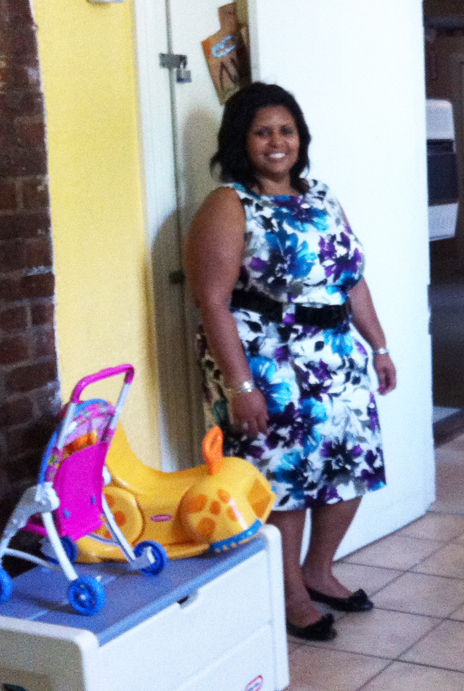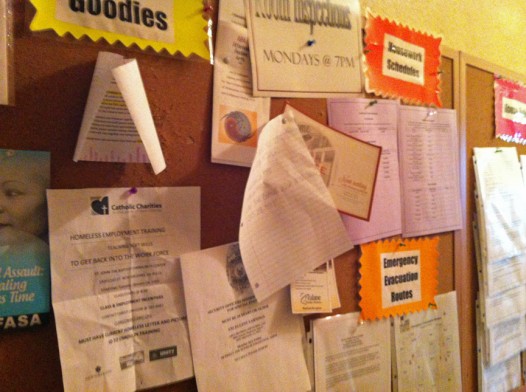
New Orleans Women’s Shelter Executive Director Dawn Bradley-Fletcher: 12 of 20 residents are children.
Homelessness, says Dawn Bradley-Fletcher, has many faces. And most of the ones she sees every day belong to kids.
As executive director of the New Orleans Women’s Shelter (NOWS), Bradley-Fletcher manages a program that transitions mothers and their children from the streets to self-sufficiency.
Her clients don’t fit the public image of the homeless, which leans toward panhandlers clutching brown bags or the mentally ill.
Those stereotypes, says Jackie Silverman, who founded NOWS after Hurricane Katrina, “are the very tip of the iceberg. We need to educate people that the homeless are not what they picture.”
The New Orleans Women’s Shelter is one of the few programs for the homeless in town that take in moms with tykes in tow. Of the 20 people currently living in the organization’s two-story group home in the Upper 9th Ward, 12 are kids.
The house is always full. And more than 100 other moms and kids are on the waiting list.
Almost all of the women and children at NOWS come from the New Orleans metro region. Most are homeless simply because they lost jobs. Higher housing costs after Hurricane Katrina, coupled with the loss of family support, have added to the numbers of local mothers with no place to call home.
Potential residents are referred to NOWS by a number of local agencies. It’s not a hand-out kind of place, but a hand-up one. So applicants are screened, and victims of domestic violence or abuse, substance abusers and the mentally ill are steered to other agencies more targeted to those needs.
At the New Orleans Women’s Shelter, the aim is transition – into housing, jobs, and schools. The organization is there every step of the way, and beyond. One recent graduate with a new degree in criminal justice is now a board member, lending her time and support to the agency that once did just that for her.
“There are options for much of the homeless population, especially once you’re over the age of 24,” says Dan Silverman, who oversees fund-raising and finances for the shelter. “But there are virtually none for homeless mothers with small children. That’s really the niche we’ve come to focus on.
“A lot of what we do here is designed to protect the children. Homelessness might be stressful to an adult, but it’s traumatic for youngsters.
“It’s amazing how many kids in the New Orleans school system are homeless,” adds Jackie Silverman. “The public has no idea.”
NOWS accepts mothers with children from birth to 12, and will make exceptions to those rules if the case warrants it. Thus they are among the few to admit pregnant homeless women, and have had a happy 21 babies born to shelter residents in the past 5 ½ years.
There’s no time frame for how long people can stay at the Women’s Shelter – past residents have been there for a few days, or for as long as 18 months. The average stay is four to six months.
Each woman is assigned a caseworker, who helps her identify personal goals and then sets up a plan to make them happen.

The ‘Goodies’ board is a spot for posting everything from coupons to a schedule of hours at nearby free clinics.
For some women, that involves getting a high-school, college or vocational degree; for others, it means job training or financial planning. Everyone gets lessons in life skills, from how to dress or create a resume to parenting classes and budgeting lessons.
Organizers think outside the box, too. One current offering is “Talk, Touch and Listen,” an eight-week workshop created by a Tulane professor that uses hair-combing and styling as a process for parent-child bonding, and to teach nurturing.
“We learn how to parent from our mothers,” says Jackie Silverman. “It you didn’t get basic parenting when you were young, you don’t have those skills. That was a big surprise to me.”
The shelter’s front double-parlor living room is a cozy place where women can chat, use the communal computer for job searches, or hang out with their kids. Bulletin boards in the hallway beyond post job openings, house rules, schedules for chores and cooking. One labeled “Extra Goodies” contains coupons and schedules for things like free health clinics.
Youngsters get attention, too: play therapy, a playroom where arts and crafts are taught, complete with a kid-friendly computer. This summer, the shelter is paying for all of them to attend day camp at a Baptist church down the street.
The idea is to offer a stable environment where women and children can stabilize their lives.
“We address all of the things that we think will affect the ability to move forward,” says Bradley-Fletcher. “We don’t ask residents to pay, but we do ask them to save 25 percent of anything they make while living here, and then we match that when they leave. It’s a great incentive.”
The organization supplies everything, from laundry detergent to pantry supplies. The refrigerator in the sunny galley kitchen is packed with staples that anyone can sample. The herb garden in the small but sun-dappled back yard is a group project.
“We’re treating this as a home,” says Jackie Silverman. “It’s not institutional. Everyone has chores, cooks one night a week, attends house meetings.”
A large shared bedroom downstairs houses single women, while five family rooms upstairs are given to mothers and kids. Most women are in their 30s, but the shelter has had residents in their 70s.
“Most women who come through here are ready to make that change,” says Bradley-Fletcher. Mothers with young children, she adds, are particularly motivated to put homelessness behind them.
The mission at NOWS is to ensure that each woman moves into independent living, supports her family, and has her children in school or daycare. In 2009, just over 50 percent of the shelter’s residents reached those goals. By 2011, NOWS had achieved an 88 percent success rate. Many graduates return to mentor those who have followed them.
“We’re getting better at figuring out the pieces,” says Dan Silverman.
Still, it’s an uphill battle to engage the community in the issue of homelessness. It’s not, says Bradley-Fletcher ruefully, a cause that people with means tend to embrace.
Currently, in addition to its small staff, the shelter is fueled mainly by donations, grants, good will, a committed landlord who is wont to stop by to make a needed repair or weed the garden, and two dozen volunteers, many of them from Tulane and Southern universities.
“The sense is that homelessness is the government’s problem, or the city’s problem,” says Bradley-Fletcher. “But we won’t be able to fight it successfully without the support of the local business community. It can’t be just a matter of getting the homeless off the streets for the tourists.”
Addressing homelessness, agrees Jackie Silverman, “has to involve more than sweeping it under the rug.”
Renee Peck is editor of NolaVie.
 NOLAbeings Multimedia artist Claire Bangser created NOLAbeings as a portrait-based story project that marries...
NOLAbeings Multimedia artist Claire Bangser created NOLAbeings as a portrait-based story project that marries...  Voodoo in New Orleans: Reviving history: New Orleans fortune telling This article takes a deep dive into the history of Voodoo in New Orleans, its hybridization with Catholicism, and its present-day place in the city's culture. The author visits fortune-tellers in the French Quarter, using their guidance as a tool for introspection rather than a deterministic predictor of the future. Through her experiences in New Orleans, the author feels a mystical connection to both the past and the future.
Voodoo in New Orleans: Reviving history: New Orleans fortune telling This article takes a deep dive into the history of Voodoo in New Orleans, its hybridization with Catholicism, and its present-day place in the city's culture. The author visits fortune-tellers in the French Quarter, using their guidance as a tool for introspection rather than a deterministic predictor of the future. Through her experiences in New Orleans, the author feels a mystical connection to both the past and the future. 